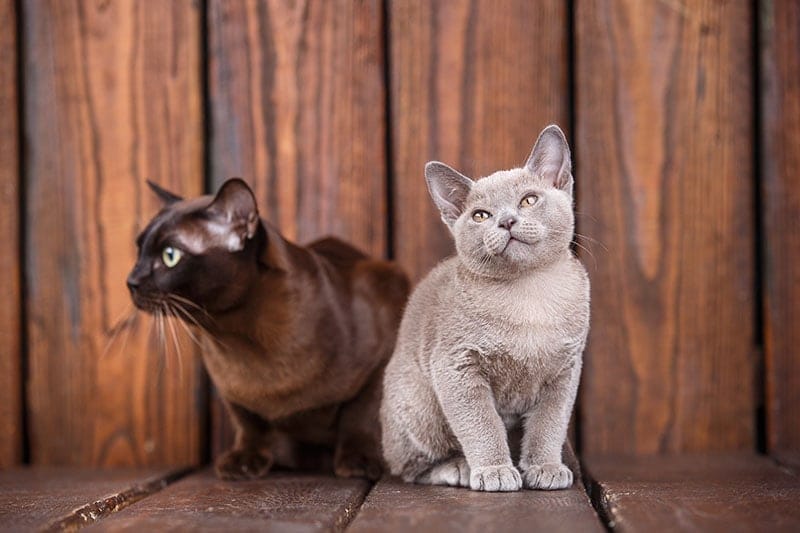The European Burmese cat originated as a breed in Europe, where they were likely bred from imports of Burmese cats from Southeast Asia. They are an established pedigree breed rather than a mixed breed. Some likely founding breeds include the Siamese, British Shorthair, and Burmese cat breeds.
Introduction European Burmese Cat Breed
The European Burmese cat is a highly social and playful feline that thrives when given lots of human interaction. They have a medium, muscular build and bright, inquisitive eyes that seem to sparkle with mischief. Cats are very vocal and love to communicate with their pet parents. While demanding of attention, they reward their families with unwavering loyalty and affection.

Affectionate with Family: ⭐⭐⭐⭐⭐
Amount of Shedding: ⭐⭐
General Health: ⭐⭐⭐
Potential for Playfulness: ⭐⭐⭐⭐⭐
Tendency to Vocalize: ⭐⭐⭐⭐⭐
Kid-Friendly: ⭐⭐⭐⭐
Friendly Toward Strangers: ⭐⭐⭐
Easy to Groom: ⭐⭐⭐⭐
Intelligence: ⭐⭐⭐⭐
Pet Friendly: ⭐⭐⭐
- Appearance: Medium size, muscular body, round head, bright eyes. Short, close-lying coat.
- Characteristics: Vocal, people-oriented, playful and active. Forms close bonds with family.
- Popularity: Gaining popularity but still fairly uncommon outside of Europe.
- Temperament: Extremely affectionate and social. Demanding of attention. Intelligent and curious.
- Lifespan: 10-15 years on average.
- Coat Color: Various colors including brown, blue, champagne. Solids, tabbies and tortoiseshells.
- Breed History: Developed in Europe likely from Burmese imports. Established pedigree breed.
Caring for a European Burmese Cat Breed
Food:
- High-quality dry food appropriate for their age. Moderate portions to prevent obesity.
- Wet food adds variety and hydration. Feed a seafood, chicken or turkey recipe.
- Occasional treats like freeze-dried meat or meat-broth mousses.
Environment:
- Active cats that need interactive playtime daily. Cat trees, scratching posts and puzzle toys provide enrichment.
- Relatively adaptable but prefer a home with access to human interaction. Do best with another pet.
- Need oversight outdoors as they may try to escape to find company.
Grooming:
- Short coat requires weekly brushing to remove dead hair and distribute skin oils.
- Check ears weekly for buildup and signs of infection. Clean gently with cotton ball if needed.
- Trim nails every 2-3 weeks to avoid overgrowth and splitting.
- Brush teeth and provide dental treats to prevent tartar buildup.

Take Care Method: European Burmese thrive when given ample human interaction daily. Engage them in play, training, lap time, and conversation to meet their social needs.
Adopting/Buying a European Burmese
- Locations of Popularity: Most common in northern and western Europe including UK, Germany, Netherlands.
- Average Price: $600-$1000 USD. More from reputable breeders with pedigree.
- Adoption/Rescue: Pedigree rescue organizations like Birman Rescue. Check local shelters/rescues too.
What to Check Before Adopting/Buying:
- General Health: Healthy weight, clear eyes/nose, clean ears and teeth. Strong but not overweight.
- Vaccine Status: Current on all age-appropriate vaccines. Kittens need boosters.
- Medical History: Review records for prior illness, surgeries, genetic conditions. Reputable breeders screen.
Preparing for a European Burmese
Here are a few tips to prepare for your new European Burmese cat:
- Cat-proof your home by securing screens, storing breakables, and keeping toilet lids down. Stock up on supplies.
- Have regular vet visits scheduled for exams, vaccines, preventatives like flea/tick medication.
- Buy interactive toys to provide physical and mental stimulation. Laser pointers and feather wands are great.
- Feed a nutritious cat food diet. Follow portions for their age and activity level. Ensure fresh water.

- Common Diseases: Diabetes, heart disease, dental issues. Vet visits help catch problems early.
- Recommended Vaccines: FVRCP, FeLV, Rabies and any others advised by your vet.
Popular Names
Choose fun, playful names that match the European Burmese’s lively spirit:
Luna, Lily, Daisy, Lucy, Nala, Stella, Chloe, Cleo, Zoe, Oscar, Leo, Milo, Simba, Oliver, Charlie, Felix
Do European Burmese cats like going outside rather than staying home?
Enjoy exploring outdoors but should be supervised for safety. It’s best to create an enriched indoor environment with cat trees, toys, and human company.
Are European Burmese cats smart?
Yes, cats are highly intelligent cats. They can learn tricks, walk on a leash, and figure out how to open doors and cabinets! You must keep them mentally stimulated.
How many types of European Burmese cats are there?
There are three coat color variations: brown, blue, and champagne. All have bright golden to yellow eyes. Patterns include solid, tabby and tortoiseshell.
How to stop a European Burmese cat from biting?
Consistently say “no” when they bite and ignore them briefly. Redirect biting onto appropriate chew toys instead. Praise gentle play.
How to stop a European Burmese cat from scratching?
Provide plenty of scratching posts. Use cat-safe deterrent sprays on off-limit areas. Reward them for using the posts. Keep their nails trimmed.
How to socialize and raise a friendly European Burmese cat?
Socialize them young through positive experiences with different people, pets and environments. Offer praise and treats for good behavior around strangers.
How to train your European Burmese cat?
Use positive reinforcement like treats to train desired behaviors. Work on basics like coming when called, not jumping on counters, and tolerating being groomed.
How often should a European Burmese cat see the vet?
Annual exams are recommended, with twice yearly senior checkups over age 7. Sick visits anytime something seems wrong. Dental cleanings help prevent disease.
Are European Burmese cats good family pets?
Yes, cats thrive in families that provide them with lots of playtime, attention and interaction daily. Supervise young kids.
Are European Burmese cats good with children?
Tend to do very well with respectful, gentle kids. Supervise play and teach children how to properly handle them.
Are European Burmese cats good with other animals?
When properly socialized, European Burmese generally coexist well with other pets. A rambunctious dog may be overwhelming though.
Can European Burmese cats cause allergies?
Cats do produce allergens like all cat breeds. While no cat is hypoallergenic, their short coat produces less dander than long-haired breeds.
Are European Burmese cats ferocious?
No, European Burmese have a sweet, affectionate temperament and tend to get along well with everyone when socialized young. They are not aggressive cats.
Do European Burmese cats have a lot of hair loss problems?
No, European Burmese cats have a short, sleek coat that generally does not have excessive shedding or hair loss issues. Seasonal shedding is normal.
Are you a cat lover who wants to learn more about your furry friends? Do you want to find the best cat food, cat care tips, and resources for your cats? If so, you’ve come to the right place! Welcome to Cat Food Site, the ultimate website for cat enthusiast.
Here you will find everything you need to know about cats Breed, from their health and behavior to their breeds, cat diet and names. You will also discover the latest cat news, cat nutrition, trends, and memes from around the web.

